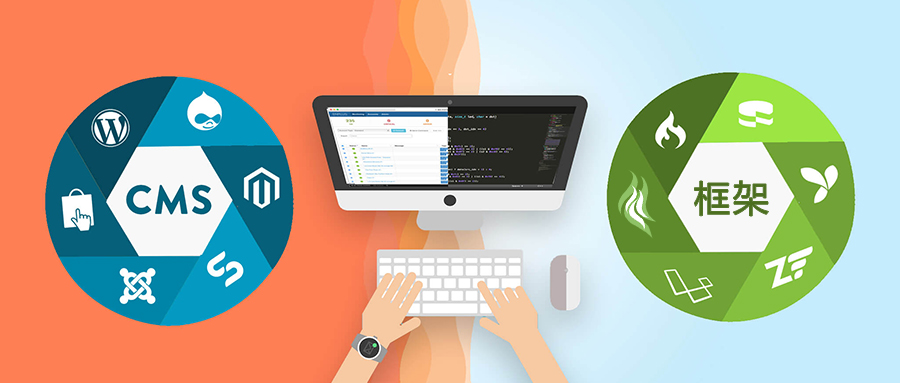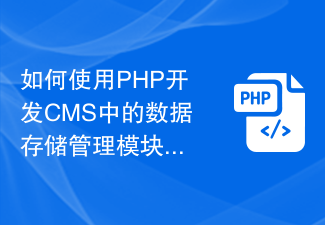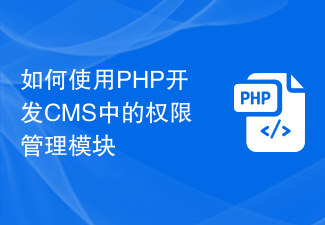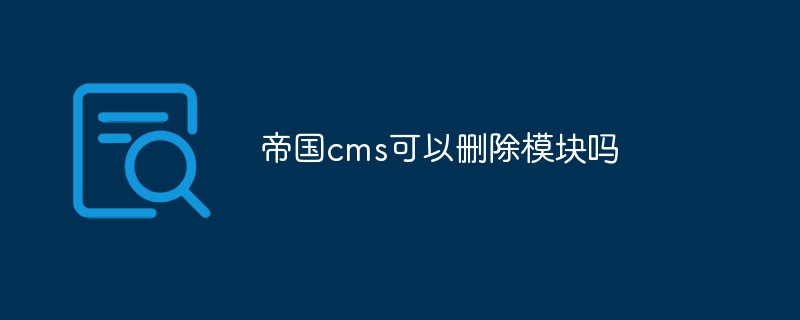 Backend Development
Backend Development PHP Tutorial
PHP Tutorial Uncovering the technology behind integrating PHP frameworks with CMS
Uncovering the technology behind integrating PHP frameworks with CMSIntegrating a PHP framework with a CMS involves the following steps: Establishing a bridge connecting the functionality of the framework to the CMS. Use hooks to associate framework events with CMS actions. Override CMS components to customize key functionality.

Uncovering the technology behind the integration of PHP framework and CMS
Introduction
Integration of PHP frameworks and content management systems (CMS) is crucial in modern web development. This article will delve into the technical details behind the integration process and provide a practical example to help you understand how it works.
Technical integration
Integration of PHP framework and CMS usually involves the following steps:
- Building a bridge:Create Code bridge to connect the functionality of the framework and CMS.
- Hooks: Use hooks to associate framework events with CMS actions.
- Overrides: Override CMS components to gain custom control over key functionality.
Practical Case: Laravel and WordPress
To demonstrate the integration process, we use the Laravel framework and WordPress CMS.
Building a Bridge
We create a class called WordPressBridge.php:
class WordPressBridge {
public function init() {
// 加载 WordPress 功能
require_once(ABSPATH.'wp-load.php');
}
}Hook
We use Laravel's boot method to register a hook:
public function boot() {
app()->singleton('WordPressBridge', function () {
return new WordPressBridge();
});
}Override
We create a custom template file to Override the default template file of WordPress:
@extends('layouts.app')
@section('content')
@wordpress()
@endsectionResult
After integration, we can easily access and use WordPress features such as post management, user management and Custom fields.
Conclusion
By building bridges, using hooks and overriding components, we can seamlessly integrate PHP frameworks and CMSs. This allows us to create feature-rich and powerful web applications that take advantage of frameworks and CMSs.
The above is the detailed content of Uncovering the technology behind integrating PHP frameworks with CMS. For more information, please follow other related articles on the PHP Chinese website!
 帝国cms管理员在哪个表Feb 22, 2023 pm 07:00 PM
帝国cms管理员在哪个表Feb 22, 2023 pm 07:00 PM管理员表有:1、phome_enewsuser,是管理员记录表;2、phome_enewsdolog,是管理员操作记录表;3、phome_enewsgroup,是管理员用户组数据记录表;4、phome_enewslog,是管理员登陆日志;5、phome_enewsloginfail,是管理员登陆失败记录表;6、phome_enewserrorclass,是管理员错误报告记录表。
 什么是PHP框架?PHP框架与CMS的区别Jun 13, 2022 pm 02:21 PM
什么是PHP框架?PHP框架与CMS的区别Jun 13, 2022 pm 02:21 PM在编程中,框架扩展了构建通用软件应用程序的支撑结构。在你开始编码之前,框架就会将程序的基本功能插入到你的应用程序中,从而简化了软件的开发过程。
 如何使用PHP开发CMS中的数据存储管理模块Jun 21, 2023 am 09:01 AM
如何使用PHP开发CMS中的数据存储管理模块Jun 21, 2023 am 09:01 AM随着互联网技术的不断发展,内容管理系统(CMS)越来越受到广泛关注,尤其是对于企业和机构等需要频繁更新和发布内容的组织。在CMS中,数据存储管理是一个重要的模块,它负责管理系统中的数据,包括创建、更新、删除和查询数据等操作。而PHP作为一种开发CMS的常用语言,本文将介绍如何使用PHP来实现CMS中的数据存储管理模块。1.选择适合的数据库在开发CMS的数据存
 如何使用PHP开发CMS中的权限管理模块Jun 21, 2023 am 08:43 AM
如何使用PHP开发CMS中的权限管理模块Jun 21, 2023 am 08:43 AM随着互联网的普及和发展,更多的网站和应用程序需要实现权限管理模块,以保护自身的安全和保密性。而作为一种流行的后端编程语言,PHP也广泛应用于各种CMS(ContentManagementSystem)中,如WordPress、Joomla、Drupal等。因此,在本文中我们将探讨如何使用PHP开发CMS中的权限管理模块。一、CMS中的权限管理模块在CMS
 织梦cms是什么语言写的Feb 21, 2023 am 09:45 AM
织梦cms是什么语言写的Feb 21, 2023 am 09:45 AM织梦cms是用PHP语言写的。织梦CMS(DedeCMS)是一个PHP开源网站管理系统,作用是构建中小型网站;它采用PHP+MySQL技术开发,可同时使用于windows、linux、unix平台。
 帝国cms可以删除模块吗Mar 13, 2023 pm 07:18 PM
帝国cms可以删除模块吗Mar 13, 2023 pm 07:18 PM帝国cms可以删除模块。删除模块的方法:1、登录帝国CMS后台,依次点击“系统”-“系统设置”-“系统参数设置”-“关闭相关功能”,根据自己网站的需求,自行勾选设置来关闭对应的模块功能;2、关闭功能后,删除对应模块的在e目录下的子目录;3、修改e目录下的php文件,在文件第二行加上代码“exit();<?php exit()”,并保存修改即可。
 帝国cms封面模板是什么意思Feb 13, 2023 am 10:39 AM
帝国cms封面模板是什么意思Feb 13, 2023 am 10:39 AM在帝国cms中,封面模板是指网站频道页面使用的模板,可以制作跟首页一模一样的封面页面;封面模板共使用在两个地方:非终极栏目和专题。封面模板的使用,一般是该栏目为父级栏目(非终级栏目),封面模板的目的就是调用各个子栏目(终级栏目)文章。
 如何快速入门并运用PHP开发CMS系统Jun 21, 2023 am 09:36 AM
如何快速入门并运用PHP开发CMS系统Jun 21, 2023 am 09:36 AM随着互联网的发展,CMS(内容管理系统)系统成为了很多网站的必备工具,而PHP作为目前最流行的网站开发语言之一,也成为了大多数CMS系统的开发语言。如果你想快速入门并运用PHP开发CMS系统,以下是一些指导:第一步:学习PHP基础知识在学习如何使用PHP开发CMS系统之前,你需要掌握PHP的基础知识,包括如何创建基本的PHP文件、如何使用变量和数据类型、如何


Hot AI Tools

Undresser.AI Undress
AI-powered app for creating realistic nude photos

AI Clothes Remover
Online AI tool for removing clothes from photos.

Undress AI Tool
Undress images for free

Clothoff.io
AI clothes remover

AI Hentai Generator
Generate AI Hentai for free.

Hot Article

Hot Tools

SublimeText3 Chinese version
Chinese version, very easy to use

SublimeText3 English version
Recommended: Win version, supports code prompts!

MantisBT
Mantis is an easy-to-deploy web-based defect tracking tool designed to aid in product defect tracking. It requires PHP, MySQL and a web server. Check out our demo and hosting services.

Dreamweaver CS6
Visual web development tools

WebStorm Mac version
Useful JavaScript development tools




